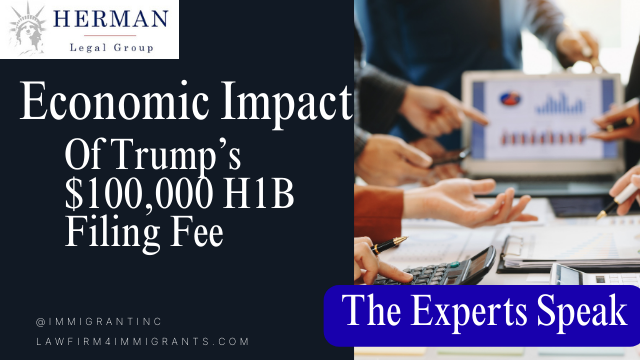On September 19, 2025, President Trump issued a Proclamation restricting entry of H-1B nonimmigrant workers and imposing a $100,000 filing fee on new petitions filed after 12:01 a.m. EDT, September 21, 2025 (eastern daylight time). According to the White House proclamation and USCIS FAQs, the fee is one-time, not annual—it is a one time fee as described in the official guidance—and does not apply to petitions filed before the effective date or to valid existing H-1B visa holders.
The technology industry and tech industry are among the most affected by the new fee. A White House official confirmed key details about the policy. But many details remain unclear, including whether transfers, cap-exempt employers, and change-of-status filings are covered.
The Trump administration’s stated goal is to protect American wages and prioritize the interests of the American worker. This sweeping change has sent shockwaves through employers, foreign workers, and entire industries. Many employers and business leaders are concerned about the impact of the fee.
The fee particularly affects skilled foreign workers and highly skilled workers in specialized fields. The new fee may make it harder for companies to attract the best temporary foreign workers and foreign talent. The H-1B program was originally designed to address labor shortages in specialty fields, but critics argue it has sometimes led to the replacement of domestic employees with lower paid foreign labor.
Why This Matters
This change is the largest single fee hike in U.S. immigration history, representing a significant increase in visa fees and imposing new visa fees under the proclamation. It directly impacts employers, foreign workers, and entire industries dependent on H-1B talent. The new fee requirement is in addition to existing fees, creating a substantial financial burden for current applicants, new applications, and renewal extensions.
The proclamation is written broadly, but agency implementation guidance is narrower, leaving employers in a legal gray zone. Lawsuits are expected, but businesses and workers must act now under current rules. Many stakeholders are awaiting more guidance from USCIS and the White House on the implementation of the new fee.

The Top 10 Questions About the H-1B $100,000 Fee for Foreign Workers
1. Who has to pay the $100,000 H-1B fee?
Official Answer:
- The White House proclamation states that all new H-1B petitions filed after Sept. 21, 2025 must include the $100,000 fee.
- The USCIS FAQ confirms it does not apply to petitions filed before the deadline.
- Existing H-1B visa holders are exempt for reentry and travel.
Unanswered:
- Are change-of-employer petitions (H-1B portability) subject to the fee?
- Are amendments that involve a material change in job location or role considered “new” and thus covered?
- Will subsequent fees be required for multiple filings or amendments, and could these additional costs accumulate for employers, especially impacting small businesses?
- Will cap-exempt employers (universities, nonprofits, research institutions) be exempted by DHS discretion?
Key Resource:USCIS H-1B FAQ
2. Is the $100,000 fee a one-time payment or annual?
Official Answer:
- Both the White House fact sheet and USCIS FAQ confirm: the fee is a one-time payment per new petition, not annual.
Unanswered:
- If a worker changes employers multiple times, must each new petition carry the $100,000?
- What about cap-subject re-filings after a denial—do those count as new? Will existing fees paid for the original filing be credited toward the new filing, or will applicants need to pay the full amount again?
3. When does the rule take effect?
Official Answer:
- Effective 12:01 a.m. EDT, September 21, 2025.
- Petitions filed and accepted by USCIS before that date are exempt.
Unanswered:
- Does the timestamp apply to receipt notice issuance or delivery to USCIS lockbox?
- How will USCIS handle filings that arrive on Sept. 20 but are receipted Sept. 22?
Key Resource: White House Proclamation
4. Are H-1B extensions or renewals subject to the fee?
Official Answer:
- USCIS states that extensions and renewals with the same employer and role are not subject to the $100,000 fee.
Unanswered:
- What if there is a promotion or job role change—is that considered an amendment (new petition) or extension?
- Will extensions filed late or after a lapse be treated as new filings?
In both cases, more guidance from USCIS is needed to clarify how these scenarios will be handled.
5. What about H-1B transfers (change of employer)?
Official Answer:
- The proclamation doesn’t mention transfers explicitly.
- USCIS FAQ avoids the issue.
Unanswered:
- Are portability petitions treated as “new” (and thus subject)?
- Or are they protected since the worker already held H-1B status?
- Employers and attorneys disagree until USCIS issues a procedural memo.
Key Resource: USCIS Policy Memo on H-1B Processing
6. Does the fee apply to H-1B filings inside the U.S., or only to consular cases?
Official Answer:
- Proclamation language is entry-focused (affecting nonimmigrants entering the U.S.).
- USCIS FAQ frames it more broadly: “any new petition” filed after Sept. 21.
Unanswered:
- Will USCIS actually enforce the fee on domestic change-of-status cases?
- Or is the intention mainly to deter new entries from abroad?
7. Are dependents (H-4 spouses and children) affected?
Official Answer:
- The $100,000 fee is tied to H-1B principal petitions, not H-4 filings.
- H-4 dependents remain eligible for visas and work authorization (H-4 EAD), subject to current rules.
Unanswered:
- If the H-1B principal is blocked due to nonpayment, what happens to dependent travel or status renewals?
8. How is the $100,000 fee paid, and is it refundable?
Official Answer:
- DHS has announced that employers must pay via a designated payment portal (to be linked by USCIS).
- Employers must retain proof of payment for compliance and audits.
Unanswered:
- If the petition is denied, will the $100,000 be refunded? (No guidance yet.)
- Can employers apply the fee to a resubmitted petition if the first was rejected?
9. Can employers shift the $100,000 cost to employees?
Official Answer:
- Current DOL and USCIS rules prohibit passing most H-1B costs to employees if doing so reduces wages below the required level.
- The $100,000 fee appears to be an employer obligation.
Unanswered:
- Could USCIS carve out exceptions?
- How will enforcement handle cases where employees indirectly reimburse employers (via salary deductions, repayment agreements, etc.)?
10. Will the rule face legal challenges or be overturned?
Official Answer:
- Multiple law firms and advocacy groups are preparing to challenge the fee in federal court.
- Legal arguments include:
- The President exceeded statutory authority under the INA.
- Improper taxation without Congress.
- Violation of APA (Administrative Procedure Act).
Unanswered:
- Will courts issue a temporary injunction halting the rule?
- Could the fee be partially struck down (e.g. limited to consular cases)?
- How quickly will litigation move—before the FY2027 cap season?
H1B Data
- Line Graph: H-1B Filings (2018–2026) vs. New $100,000 Fee (2025)– Showing expected drop-off in filings post-fee.
The line graph illustrates the trend in H-1B filings from 2018 to 2026, with a projected decline after the introduction of the new $100,000 fee in 2025. Notably, Amazon and its cloud computing unit, AWS, have been the largest beneficiary of H-1B approvals in recent years, underscoring their prominence in the technology and cloud services industry.
As the U.S. increases fees and restrictions, some skilled workers may choose to move to other countries with more favorable immigration policies.

- Bar Chart: Employer Cost Breakdown
- Prevailing wage, attorney fees, existing USCIS fees, + new $100,000 surcharge.
The bar chart breaks down the total costs employers face when sponsoring H-1B visas, including prevailing wage, attorney fees, existing USCIS fees, and the new $100,000 surcharge. Major tech companies, such as Cognizant Technology Solutions, rely heavily on H-1B visas to hire technology workers and foreign national talent. Start ups may be disproportionately affected by the new fee, as increased costs could create significant barriers for early-stage companies seeking to hire international skilled professionals. H-1B eligibility is limited to specialty occupations that typically require at least a bachelor’s degree. The H-1B program was designed to allow U.S. employers to hire temporary foreign workers in fields where there is a shortage of qualified domestic candidates.
After factoring in all costs, the current lottery system for H-1B visas may be impacted by the new fee, potentially reducing the number of applications. Proposed reforms could shift to a wage-based or weighted lottery system, which would favor higher-paying job offers and affect the chances for different applicants.

Take the Uncertainty Out of the H-1B Proclamation — Get the Guidance You Deserve
The September 19, 2025 H-1B Proclamation and the unprecedented $100,000 filing fee have left both employers and employees anxious, confused, and uncertain about the future. You do not have to face these challenges alone.
For more than 30 years, Attorney Richard T. Herman has been a trusted advocate for immigrants, entrepreneurs, and businesses navigating the shifting tides of U.S. immigration law. As an experienced immigration attorney, Richard has worked closely with immigration lawyers nationwide to provide legal guidance on complex immigration matters. As the **co-author of Immigrant, Inc.—**a landmark book celebrating the power of immigrant innovation—Richard has dedicated his career to championing global talent and helping employers harness the skills that drive America’s growth. He also advises clients on pathways to permanent residency as an alternative to the H-1B visa.
Richard understands not only the complex legal rules, but also the human stress, fear, and disruption that sudden immigration changes create for families, workers, and companies. Whether you are an employer trying to protect your workforce, or an employee worried about your future in the U.S., you deserve an advocate who combines legal skill, business insight, and deep empathy for the immigrant experience.
Now more than ever, the stakes are too high to take chances. Get the clarity, confidence, and strategic planning you need to protect your future.
👉 Schedule Your Confidential Consultation with Richard Herman Today** or call 216-696-6170.**
Comprehensive Resource List: H-1B Proclamation (9/19/2025) + USCIS FAQs & Memo
1) White House / Presidential Materials
- Presidential Proclamation (Full Text) – Restriction on Entry of Certain Nonimmigrant Workers (effective 12:01 a.m. EDT, Sept. 21, 2025; 12-month duration unless extended). Issued by President Donald Trump as part of the Trump administration’s immigration reforms. whitehouse.gov – Proclamation (The White House)
- White House Fact Sheet – Plain-English summary of the policy intent and implementation direction. whitehouse.gov – Fact Sheet (The White House)
- White House FAQ (Media/Briefing page) – Quick answers aligned with the proclamation language. The White House sought to clarify the scope of the new fee, emphasizing that it does not apply to current visa holders. whitehouse.gov – H-1B FAQ (The White House)
2) USCIS (Primary Implementation Guidance)
USCIS is the primary agency responsible for immigration services in the United States, including the implementation and oversight of the H-1B visa program, which plays a significant role in U.S. immigration policy and the employment of highly skilled foreign workers. These resources are especially relevant for foreign nationals seeking H-1B status.
- USCIS H-1B FAQ (Agency) – Core clarifications: one-time $100,000 payment for new H-1B petitions filed after Sept. 21, 2025; high-level implementation notes. uscis.gov – H-1B FAQ (USCIS)
- USCIS H-1B Processing Memo (PDF) – Procedural/operational guidance for adjudicators; confirms prospective application and exemptions for petitions filed before the effective date and currently approved petitions/valid visas. uscis.gov – H1B_Proc_Memo_FINAL.pdf (USCIS)
- USCIS Policy Memoranda Index – Landing hub for policy memos (helps track updates if USCIS releases further H-1B fee/portability clarifications). uscis.gov – Policy Memoranda (USCIS)
- Background References Frequently Used in H-1B Analysis
- Simeio Amended-Petition Guidance (moves requiring a new LCA may need a new petition) – helpful for “is an amendment a new filing?” questions. uscis.gov – 2015 Simeio Guidance (PDF) (USCIS)
- AC21 & Portability (historic memo for context when evaluating transfers/“new” petitions). uscis.gov – AC21 Guidance (PDF) (USCIS)
- USCIS Data (for context/visuals) – Annual H-1B characteristics and approvals by sector, wages, etc., useful for charts. uscis.gov – FY2024 H-1B Characteristics (PDF) (USCIS)
3) U.S. Department of State (DOS) / Consular Guidance
- DOS Visa News Note on the Proclamation – How consulates approach visa issuance under the new entry restriction and $100,000 requirement.
travel.state.gov – Visa News: Restriction on Entry of Certain Nonimmigrant Workers (Travel.gov)
4) Department of Labor (DOL) – Wage/LCA Compliance (Who Pays What)
(These do not create or interpret the $100,000 fee, but they’re essential for employers evaluating what costs can/can’t be shifted to workers and how LCAs interplay with “new” vs. amended filings.)
- H-1B Program Overview (WHD) – Employer wage attestations, prevailing wage, and core LCA obligations. Wage levels are set to protect American workers and ensure fair compensation for foreign employees. dol.gov – WHD H-1B Program (DOL)
- FLAG Portal – LCA Program – Electronic LCA filing basics and program overview (H-1B, H-1B1, E-3). flag.dol.gov – LCA Program (Flag.dol.gov)
- Fact Sheet #62M (Notice to U.S. Workers) – Required worksite notice timing and content. dol.gov – FS #62M (DOL)
- Fact Sheet #62J (Place of Employment / Worksite) – When a new LCA is needed; ties into amendment vs. new petition analysis. dol.gov – FS #62J (DOL)
- H-1B Advisor (Interactive) – WHD’s guided tool for employer/employee compliance questions. dol.gov – H-1B Advisor (DOL Web Apps)
- ETA Foreign Labor – H-1B/H-1B1/E-3 Program Page – Additional procedural details from DOL’s OFLC. dol.gov – ETA H-1B/H-1B1/E-3 (DOL)
5) DHS / CBP (Ports of Entry)
This change is the largest single fee hike in U.S. immigration history, representing a significant increase in visa fees and imposing new visa fees under the proclamation. It directly impacts employers, foreign workers, and entire industries dependent on H-1B talent. The new fee requirement is in addition to existing fees, creating a substantial financial burden for current applicants, new applications, and renewal extensions. While it is a one time fee as described in the official guidance, it is not an annual fee, but a one-time charge. Additionally, the fee applies only to new applicants filing after the effective date.
The proclamation is written broadly, but agency implementation guidance is narrower, leaving employers in a legal gray zone. Lawsuits are expected, but businesses and workers must act now under current rules. Many stakeholders are awaiting more guidance from USCIS and the White House on the implementation of the new fee. There is still uncertainty about exactly which types of filings the fee applies to, such as extensions, amendments, transfers, or change-of-employer petitions.

6) Professional Associations & Practitioner Hubs
(High-quality, continuously updated practice coverage; excellent for what’s changing now and litigation tracking.)
- AILA – Practice Alerts & Press Room – Member alerts, practice resources, and public statements on the H-1B fee and related “Gold Card” proposals; good hub for legal challenges and practical filing tips. aila.org – H-1B Proclamation Practice Alert (Recent Postings) (AILA) aila.org – Press Room Statement (AILA) aila.org – Analysis/Advocacy Article (AILA)
- NAFSA – Regulatory & Policy Tracking – University/international-education perspective, rapid alerts on consular/interview-waiver shifts and employment-based policies impacting campuses and researchers. nafsa.org – Current U.S. Administration hub (NAFSA) nafsa.org – Executive & Regulatory Actions (Trump 2) (NAFSA) nafsa.org – Policy Digest 2025 (visa interview-waiver updates) (NAFSA)
- SHRM – Employer/HR Compliance Lens – HR-focused explainers on the H-1B fee’s impact on recruiting, compliance, and workforce planning. HR teams and business leaders are actively seeking guidance from SHRM on navigating the new H-1B fee and exploring alternative visa options. shrm.org – News Coverage of $100K Fee (SHRM) shrm.org – Article: Impact on Tech Sector (SHRM)
- IEEE-USA – Engineering/Tech Workforce Policy – Policy positions and commentary on H-1B changes from an engineering-workforce standpoint. ieeeusa.org – H-1B Fee Post (IEEE-USA)
7) Credible News Backgrounders
- Reuters Legal Analysis – What legal challenges to expect; scope of presidential authority and APA issues. reuters.com – Can Trump’s $100,000 fee withstand challenges? (Reuters)
- AP Coverage – Clarifies one-time nature for existing holders and immediate anxiety/implementation concerns. apnews.com – White House says fee won’t apply to existing holders (AP News)
- Bloomberg News – Provides in-depth analysis of the H-1B visa program and recent policy changes affecting applicants and empl








